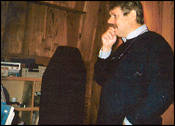| Columns Retired Columns & Blogs |
Cutting Up: Stereophile's Liszt Piano Sonata LP Page 3
Examining the cutter-head assembly, Stan was stunned to find that the new stylus was, in fact, defective. We all breathed a sigh of relief. Everyone knew that something would go wrong; we'd gotten our disaster out of the way early, we figured, and it was relatively minor.
"Whew," sighed Don MacInnis. "I thought we'd blow the whole day trying to link up our gear with yours. This is nothing compared to that."
 Stan set the reference levels and the preview time, made sure the cutter-head was functioning smoothly with the new new stylus, and we were ready to cut our first real lacquer of the day at 11:28am—not too shabby. "Believe it or not, if you talk while we're cutting the lead-in and early grooves, you can actually modulate the lacquer to the extent that you can hear it on playback," Stan cautioned. We fell into respectful silence—even Chad. After about 60 measures, Stan quietly said, "Don't be startled. I'll be switching between the preview and the master from time to time."
Stan set the reference levels and the preview time, made sure the cutter-head was functioning smoothly with the new new stylus, and we were ready to cut our first real lacquer of the day at 11:28am—not too shabby. "Believe it or not, if you talk while we're cutting the lead-in and early grooves, you can actually modulate the lacquer to the extent that you can hear it on playback," Stan cautioned. We fell into respectful silence—even Chad. After about 60 measures, Stan quietly said, "Don't be startled. I'll be switching between the preview and the master from time to time."
JA responded, "I'm assuming that's why I didn't hear the first note of the piece."
"Actually, I haven't switched anything yet," Stan replied.
We scrubbed that cut and synched the master carefully. John had recorded a 1kHz reference tone 20 seconds before the music began, so we went back to the tone and counted off 15 seconds of silence. We cued another lacquer and started over. The first side doesn't even boast any band separations, so we all lost ourselves in the music—at this point, there's just not much to do. John was on his knees in front of the table behind Stan's console.
"You want a chair?" Stan asked.
"No, this is the proper position for prayer."
At 12:11pm, with six minutes left to the side, Stan looked up from the console and exclaimed, "This sounds a hell of a lot better than that CD you sent me."
"That's the difference between 20-bit resolution and 16-bit," I interjected.
"It doesn't sound like digital at all."
The side ended and we all examined the lacquer—without touching it. It looked perfect. Stan had spaced the grooves so that there seemed to be plenty of "land" between the dynamic grooves, and the 21-minute side spread over the blank evenly. This is tricky; you want to use as much of the disc as possible, but without bunching up too much music—especially dynamic passages—in those inner grooves where the groove velocity is so much slower.
Just to be on the safe side, we cut another side A. This, too, was uneventful. John remained on his knees, alternately chewing on his cuticles and the ends of his mustache. At side end, Chad, Stan, and I high-fived one another and started discussing lunch—it was going on 1pm. John interrupted our chatter.
"Stan, can you dig out the CD we sent you? I think I need to check something." We'd routed so many wires through different paths during the morning that Don had to dig up a pair of headphones in order for John to hear the CD player. He listened and glowered. "Can I hear the beginning of the master tape, please?" he requested.
 As we heard the beginning of the sonata for the fourth time that morning, John groaned and smacked his forehead. "We don't have the first note on the master!" he wailed. It seemed that when John had mixed the data to the Nagra tape the night before we flew out to AcousTech, he had decided he needed to add some more ambience before the first piano note to allow for the LP lead-in—but under the time pressure he'd inserted the ambience before the second note of the Sonata, not the first. Murphy's Law wins again! "Damn, damn, damn!"
As we heard the beginning of the sonata for the fourth time that morning, John groaned and smacked his forehead. "We don't have the first note on the master!" he wailed. It seemed that when John had mixed the data to the Nagra tape the night before we flew out to AcousTech, he had decided he needed to add some more ambience before the first piano note to allow for the LP lead-in—but under the time pressure he'd inserted the ambience before the second note of the Sonata, not the first. Murphy's Law wins again! "Damn, damn, damn!"
Subdued, we went to lunch. Stan, Don, Chad, and I traded stories of our biggest blunders, thinking that John might derive some measure of comfort from them. Fat chance. The man was inconsolable.
- Log in or register to post comments




































